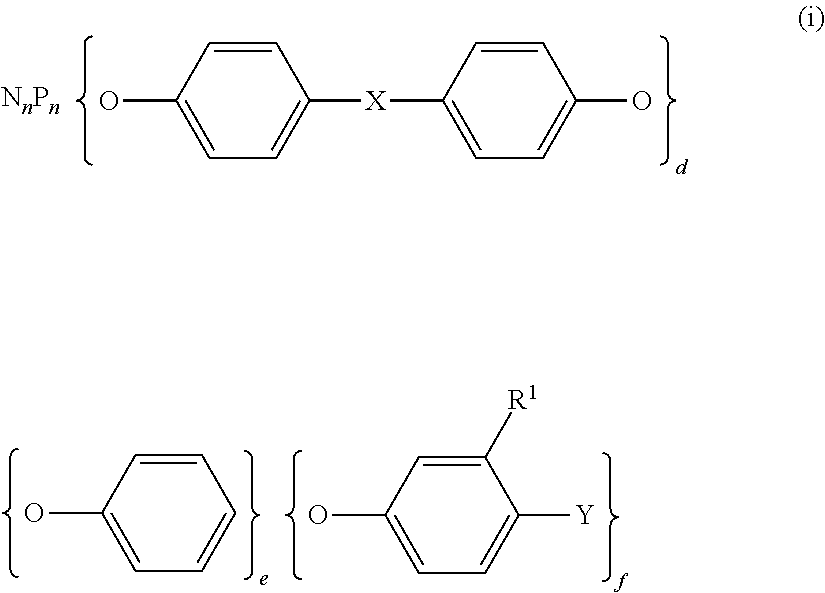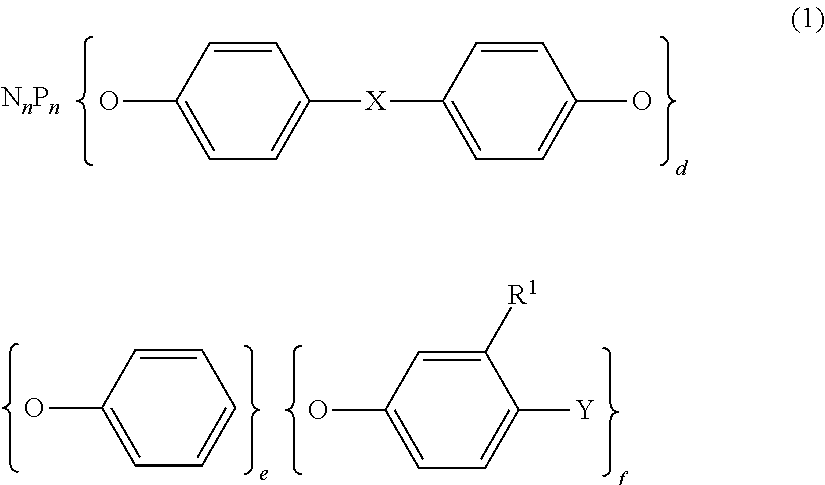Semiconductor encapsulating epoxy resin composition and semiconductor device
a technology of epoxy resin and semiconductors, applied in the directions of semiconductor/solid-state device details, synthetic resin layered products, transportation and packaging, etc., can solve the problems of reducing mechanical strength and electrical properties, using alternative compounds, and molding defects such as voids and wire flow, so as to improve heat resistance and flame retardance, the effect of less impurity ions
- Summary
- Abstract
- Description
- Claims
- Application Information
AI Technical Summary
Benefits of technology
Problems solved by technology
Method used
Image
Examples
example
[0081]Examples of the invention and Comparative Examples are given below together with synthesis examples of phosphazene compounds, for further illustrating the invention, but are not intended to limit the invention. All parts are by weight. Me is methyl.
synthesis example a
[0082]In a nitrogen atmosphere and at 0° C., 8.6 g (214 mmol) of sodium hydride was suspended in 50 ml of THF. To the suspension, 19.8 g (211 mmol) of phenol in 75 ml of THF was added dropwise. After 30 minutes of stirring, 12.0 g (34.5 mmol) of hexachlorotriphosphazene in 75 ml of THF was added dropwise, and the resulting solution was heated under reflux for 18 hours. The solvent was distilled off in vacuum, after which methanol was added. Crystals precipitated and were washed with methanol and water, yielding 23.8 g of white crystals.
[0083]
synthesis example b
[0084]In a nitrogen atmosphere and at 0° C., 4.6 g (114 mmol) of sodium hydride was suspended in 50 ml of THF. To the suspension, a solution of 9.7 g (104 mmol) phenol and 0.40 g (1.7 mmol) 4,4′-sulfonyldiphenol in 50 ml THF was added dropwise. After 30 minutes of stirring, a solution of 12.5 g (36.0 mmol) hexachlorotriphosphazene in 50 ml THF was added dropwise, and the resulting solution was heated under reflux for 5 hours. The solvent was distilled off in vacuum, after which 150 ml of cyclohexane and 57.3 g (345 mmol) of methylhydroquinone were added. To the solution, 27.3 g (345 mmol) of pyridine was added dropwise. The solution was heated under reflux for 18 hours. The lower layer in yellow syrup form was decanted, dissolved in 80 ml of 80% acetic acid and poured into 500 ml of water whereupon crystals precipitated. The crystals were dissolved in methanol and poured into water whereupon crystals precipitated again. This procedure was repeated until the water became neutral. The...
PUM
| Property | Measurement | Unit |
|---|---|---|
| temperatures | aaaaa | aaaaa |
| molar ratio | aaaaa | aaaaa |
| molar ratio | aaaaa | aaaaa |
Abstract
Description
Claims
Application Information
 Login to View More
Login to View More - R&D
- Intellectual Property
- Life Sciences
- Materials
- Tech Scout
- Unparalleled Data Quality
- Higher Quality Content
- 60% Fewer Hallucinations
Browse by: Latest US Patents, China's latest patents, Technical Efficacy Thesaurus, Application Domain, Technology Topic, Popular Technical Reports.
© 2025 PatSnap. All rights reserved.Legal|Privacy policy|Modern Slavery Act Transparency Statement|Sitemap|About US| Contact US: help@patsnap.com



